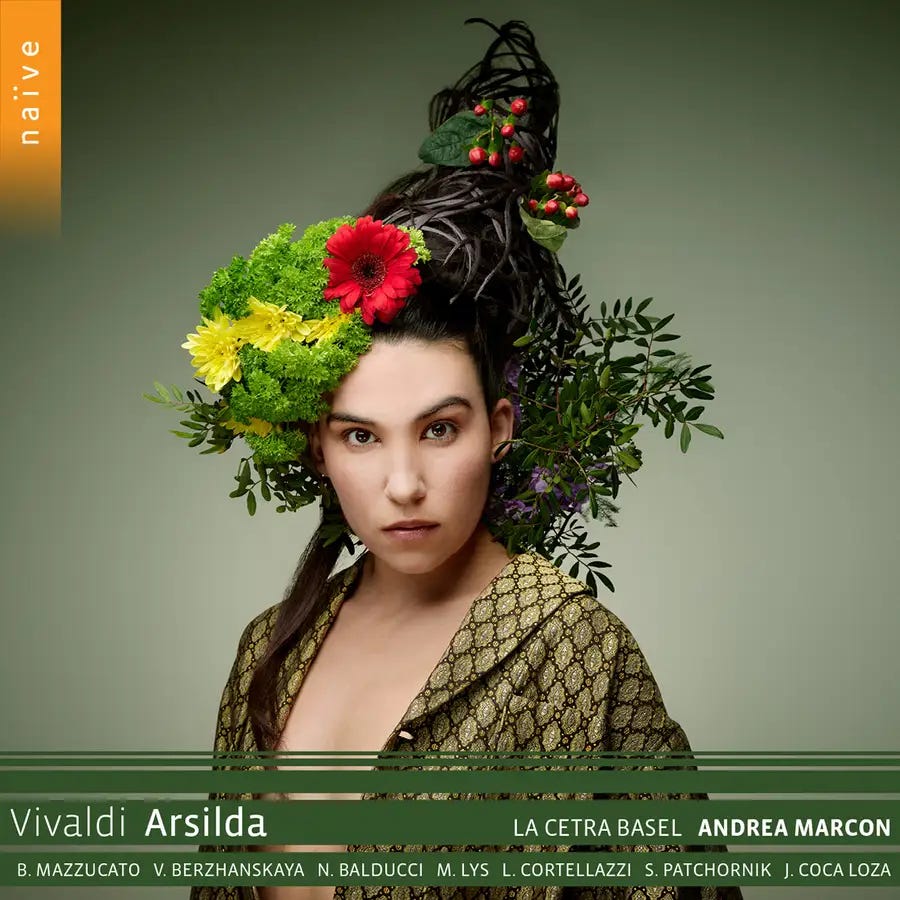Fine young mezzos lead Vivaldi Edition’s Arsilda
Arsilda, regina di Ponto marks the 20th opera release in Naïve’s Vivaldi Edition – there cannot be many more operas left to record from the National Library of Turin, which houses over 90% of the composer’s autograph manuscripts. It features La Cetra Basel directed by Andrea Marcon, their debut in Naïve’s ambitious series.
The plot is typically convoluted, so I hope you’re paying attention at the back. The opera opens with the wedding of Arsilda, Queen of Pontus, and Tamese, Prince of Cilicia… the only problem being that Tamese is missing, presumed drowned in a shipwreck, so his sister, Lisea, has disguised herself as her brother so that she can keep the throne within the family; therefore, it is Lisea who is officially presumed dead. Before this, she had been secretly engaged to Barzane, King of Lydia, who had, in the meantime, fallen in love with… you guessed it: Arsilda (he plans to abduct her). Prince Tamese, however, has survived and has returned incognito as a gardener. Only Lisea’s chambermaid, Mirinda, knows who she really is. Mirinda, of course, falls for the gardener who has saved Arsilda! Things get sticky in a tangled Baroque opera way, but fear not, it all ends happily with a double wedding.
Arsilda was an early Vivaldi opera, or dramma per musica, composed to a libretto by Domenico Lalli, whose plot borrows elements of Antonio Salvi’s libretto Rodelinda (Vivaldi’s opera precedes Handel’s) and the story of Queen Semiramis, who ruled Assyria in male disguise. It premiered at the Teatro Sant'Angelo in Venice in October 1716. Ironically, the Turin collection includes two versions of Vivaldi’s opera: a complete autograph score and, in the same folio, one which corresponds to the libretto of the version performed at the premiere.
In his booklet note, German scholar Reinhard Strohm highlights a spat between librettist and composer. In Lalli’s outspoken dedication of the libretto to the Count of Brochles, he does not sign his name and claims that Vivaldi’s “operetta” has no merit, partly due to “inadequacies on the part of the maestro who set the piece to music” and partly due to the aberrations in taste on the part of those who “wanted it so unreasonably altered”. Quite the flounce.
Strohm rejects the idea that the alterations were required by the Venetian censors, concluding that Vivaldi himself was probably responsible for the changes. He claims that there were changes to 13 of the opera’s 41 scenes. Frustratingly, it’s not entirely clear which version is used as the basis of Bernardo Ticci’s new edition for this recording, although the implication is that it’s the version that was premiered in 1716.
Unlike most of the Vivaldi Edition operas, this one has been recorded before, a 2005 release on CPO with Federico Maria Sardelli directing Modo Antiquo, which claimed to be the version originally conceived by Vivaldi and Lalli. Whichever version we have here, only one aria from Sardelli’s recording – Arsilda’s “lo sento in questo seno” – is replaced by another, “Del goder la bella speme”. There are four additional arias: “L’esser vinto non son le mie pene” (Barzane, Act 1); “Ah non so quel ch’io sento” (Barzane, Act 2); “Va superbo” (Tamese, Act 2); and the very brief “Cara gioia” (Lisea, Act 3).
Considering these minor differences, if you already have the CPO do you really need Naïve’s new account? In a word, yes. Singer for singer, with one slight caveat, Naïve’s cast is stronger, Marcon is a much more urgent, dramatic director than Sardelli and the recorded sound is brighter and more immediate.
The cast is led by two fine young mezzo-sopranos. As Arsilda, Benedetta Mazzucato has a warm tone. Her Act 2 aria “Son come farfalletta”, one of several arias referencing nature in the opera, displays wonderful lightness, while her flexibility in “Al nocchiero quant’è dolce quel pensiero” is impressive. As Lisea, Russian mezzo Vasilisa Berzhanskaya has a darker mezzo, a nice contrast, and all the vocal agility one would expect from a singer who’s established a reputation as a noted Rossinian.
Soaring above them both is sopranista Nicolò Balducci who relishes the vocal pyrotechnics as Barzane. He has an attractive voice – not as pure as Philippe Jaroussky but with bags of character. His Act 2 aria “Quell’ usignuolo”, where Vivaldi has Barzane and the orchestra chirruping like a nightingale, is one of the highlights of the recording. I wasn’t always impressed by Leonardo Coretllazzi’s undernourished tenor as Tamese, although Joseph Cornwell, his counterpart for Sardelli, sounds too ‘English choral tradition’ for Vivaldi.
Swiss soprano Marie Lys is a classy Mirinda, with a bell-like tone. She gets some wonderful arias including the charming “Io son quel gelsomino” to close Act 1, although this is an example of a rare misstep by Marcon, whose accompaniment plods in comparison to Sardelli. Soprano Shira Patchornik and bass José Coca Loza complete the cast ably in the minor roles of Nicandro and Cisardo.
Benedetta Mazzucato (Arsilda), Vasilisa Berzhanskaya (Lisea), Marie Lys (Mirinda), Shira Patchornik (Nicandro), José Coca Loza (Cisardo), Nicolò Balducci (Barzane), Leonardo Cortellazzi (Tamese) La Cetra Basel, Andrea Marcon (3 discs Naïve OP8676)




